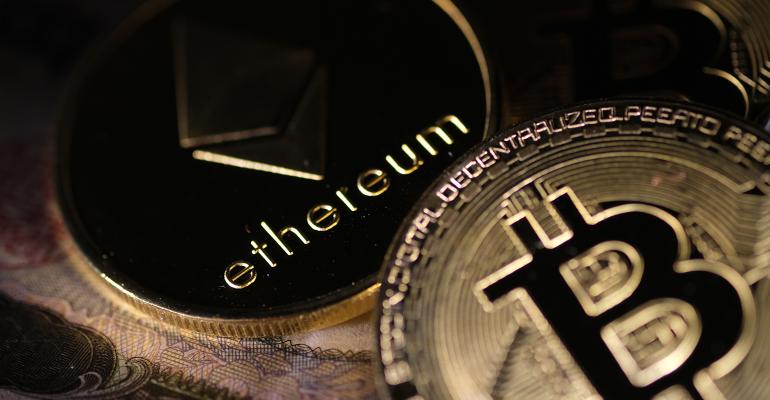With the SEC’s final authorization of spot Ethereum ETFs now official, trading of the ETFs is set to begin Tuesday morning. There is a buzz about the potential appeal of these new products. However, initial demand from RIAs is expected to be muted.
“We think if the Ethereum product gets somewhere in the range of 20% of where the Bitcoin products are, that would be a good outcome,” said Aniket Ullal, vice president of ETF data and analytics with research firm CFRA.
Ethereum is a cryptocurrency with a current market cap of approximately $416 billion, second only to Bitcoin, with a market cap of $1.32 trillion. The SEC provisionally approved eight spot Ethereum ETFs in May. The SEC asked the issuers to amend their S-1 filings before giving the final greenlight this afternoon.
On Friday, the Chicago Board Options Exchange (CBOE) posted notices that several Ethereum ETFs will begin trading on Tuesday, pending final SEC approval, which has now been received. The five funds listed by CBOE include Fidelity Ethereum Fund (FETH), VanEck Ethereum ETF (ETHV), Franklin Ethereum ETF (EZET), Invesco Galaxy Ethereum ETF (QETH) and 21Shares Core Ethereum ETF (CETH). The fees on these will range from 0.20% to 0.25%, with most of the issuers planning to waive the fees from six months to a year, depending on the investment amount.
In addition, Grayscale Ethereum Trust, a futures-based Ethereum ETF (ETHE), would be converted to a spot product with a fee of 2.5%. (Grayscale has separately filed for the Grayscale Ethereum Mini Trust (ETH), with a 0.15% expense ratio.) NYSE Arca, meanwhile, has approved both ETHE and the Bitwise Ethereum ETF (ETHW), with trading also beginning tomorrow. Meanwhile, the iShares Ethereum Trust ETF (ETHA) has been approved by NASDAQ.
While market observers expect to see some demand for spot Ethereum ETFs from RIAs, it will likely trail the industry’s appetite to date for spot Bitcoin ETFs. According to Ullal, there are at least two reasons for this. The first is that Bitcoin products tend to be a more popular choice among investors. Ullal noted that Bitcoin currently represents approximately 53% of the total crypto market, while Ethereum represents only 18%.
In addition, the adoption of spot Bitcoin ETFs has tended heavily toward individual investors and very small RIAs. CFRA has no way to gauge the exact breakdown of spot Bitcoin ETF investment between RIAs and individuals acting on their own, but a May analysis of 13F forms filed by asset managers with at least $100 million in AUM revealed they own roughly 15% to 20% of total Bitcoin ETFs shares outstanding. “We do know that it’s very much a retail demand, just based on our conversations with investors and looking into 13Fs,” said Ullal.
Similarly, Ric Edelman, founder of the Digital Assets Council of Financial Professionals, forecasts that in the first year after their launch, spot Ethereum ETFs will likely amass a third of the assets that spot Bitcoin ETFs currently have. He noted that it would take time for RIAs to get comfortable with the product and for spot Ethereum ETFs to become available on wealth management platforms.
“There will be less demand initially,” Edelman said. “Over the next year, we are expecting tens of billions of dollars to flow into these ETFs, but it won’t be immediate. I expect Ethereum ETFs to have a third of the assets that the Bitcoin ETFs have and that reflects the current market cap. As advisors gain more knowledge about the differences between Bitcoin and Ethereum, the enthusiasm for Ethereum will grow.”
Chris King, CEO of Eaglebrook Advisors, a crypto investment platform for RIAs that offers Ethereum and Bitcoin SMAs, agreed with that assessment. He said the majority of RIAs can’t recommend spot Bitcoin ETFs right now, as there are still wealth management platforms that haven’t approved them. As a result, the initial buy-in into Ethereum ETFs will likely come from self-directed retail investors and institutions.
“I think the majority of the initial flows, similar to Bitcoin ETFs, are not going to come from the wealth management channel or the advisor channel,” King said. “In the short to medium term, it’s not that demand is going to be low; it’s that there is still going to be a little bit of friction to access.”
However, King said within about eight to 12 months, the majority of flows into spot Bitcoin and spot Ethereum ETFs might start coming from the wealth channel. During that time, interest rates might fall, more wealth management platforms are likely to approve these ETFs, and upward price momentum is expected if current trends hold.
“I think there is going to be an increasing demand for risk assets, and crypto has typically been the fastest horse in the risk asset race, just like it was in 2020 and 2021," King said.
Randy M. Long, a registered financial advisor with Long Family Office, based in Reedley, Calif., noted that his firm already has a positive outlook on spot Ethereum ETFs.
“We very much support these,” he wrote in an email. “We have invested our portfolios in GBTC and ETHE for a few years now, pretty much before any other firms of which I was aware.”
According to the independent research and consultancy firm ETFGI, at the end of June, global listed crypto ETFs and ETPs reported year-to-date inflows of $45.6 billion, the highest level on record and up from roughly $566.6 million during the same period the year before. The jump in inflows reflected the SEC’s approval of spot Bitcoin ETFs. At mid-year, there were 68 Bitcoin ETFs/ETPs globally, with total assets of $65.97 billion and net new assets of $45.0 million year-to-date. There were 41 Ethereum ETFs/ETPs, with net new assets of $4.1 billion and net new assets of $116 million.





